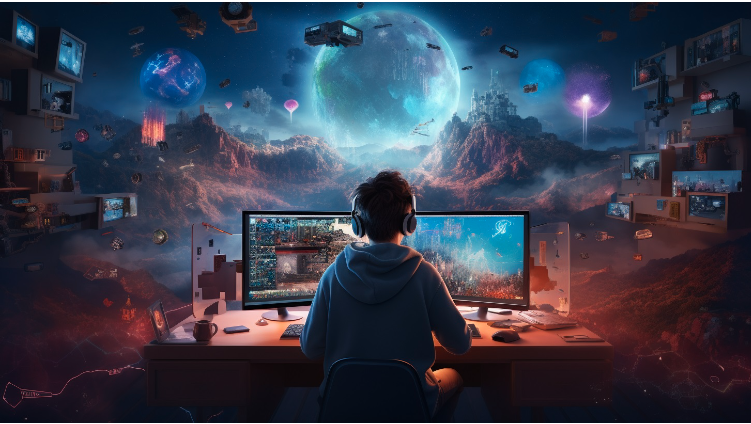Stepping into the realm of web design, where artistry, technology, and user experience converge, opens doors to boundless creativity. Within this digital canvas, catering to diverse audiences is not just a preference, but a necessity. Among these dynamic communities, the gaming enthusiasts stand out, demanding a specialised approach in website design. Crafting interfaces that resonate with gamers requires a keen understanding of their unique preferences and demands.
In this venture, we must begin by acknowledging that accessibility is paramount. Just like a welcoming casino boasting a minimum deposit of only £10, our virtual gaming spaces should be open to all potential players, ensuring an inclusive experience for enthusiasts from all walks of life. This inclusivity sets the stage for a seamless and engaging user experience that transcends barriers and invites everyone to partake in the virtual worlds we create. Join us on this exploration of essential principles for web designers to create spaces where gaming aficionados feel not just welcome, but truly at home.

Understanding the Gamer Audience
The world of gaming is a kaleidoscope of diverse preferences and interests. From enthusiastic teenagers craving the adrenaline rush of first-person shooters (FPS) and Multiplayer Online Battle Arena (MOBA) games, to seasoned adults immersing themselves in the strategic realms of role-playing games (RPGs) and tactical strategies, and even seniors finding solace in the stimulating worlds of puzzles and simulations – gamers span generations and genres. Understanding these demographics, as illuminated by Wikipedia, is crucial for web designers. By comprehending the varied tastes and preferred platforms of this multifaceted community, designers can craft websites that cater to a wide spectrum of players.
For instance, teenagers often gravitate towards high-octane FPS games, finding their thrill in action-packed scenarios like those offered by “Call of Duty” and “Overwatch”. They predominantly use PCs, consoles, and increasingly mobile devices to satisfy their gaming cravings. On the other hand, adults tend to favour RPGs such as “Final Fantasy” and “The Witcher”, as well as strategy games like “Civilization” and “Starcraft”, relishing the intellectual challenges and intricate narratives. Their gaming experiences are typically anchored in PCs and consoles. Meanwhile, seniors appreciate the cognitive engagement offered by puzzles like Sudoku and Crossword, as well as simulations such as “Flight Simulator” and “The Sims”. They may indulge in gaming on both mobile devices, PCs, and even consoles. Acknowledging these diverse preferences sets the stage for designing websites that can seamlessly accommodate a wide array of gaming experiences.
User Experience (UX) in Gaming Websites
When it comes to gaming websites, User Experience (UX) reigns supreme, serving as the linchpin upon which success is built. UX encompasses a multitude of factors that collectively shape how users interact with and perceive a website, and in the world of gaming, it’s not just an afterthought but the very essence of design.
Intuitive Navigation
Intuitive navigation is akin to a well-marked trail through a forest; it guides users effortlessly to their destination. For gamers, this means a clear, easily understandable menu structure that leads them to the content they crave. This may involve categorising games by genre, providing filters for platform compatibility, or creating a seamless journey from landing page to gameplay. By prioritising intuitive navigation, we ensure that gamers can delve straight into their preferred experiences without unnecessary detours.
Responsive Design
In an era where gaming isn’t confined to desktops, responsive design is a non-negotiable feature. It’s about ensuring that a website adapts seamlessly to various devices, be it a PC, tablet, or smartphone. This way, gamers can access their favourite content regardless of their chosen platform. It’s about maintaining a consistent and enjoyable experience, regardless of screen size or resolution.
Load Times and Performance
In the fast-paced world of gaming, seconds can make all the difference. Slow load times can turn eager players into frustrated ones. Optimising load times involves compressing images, minifying code, and leveraging caching techniques. Furthermore, ensuring high performance across a spectrum of devices ensures that the website doesn’t just load quickly but operates smoothly, providing a seamless experience for all gamers.

Visual Aesthetics and Artistic Elements
In the dynamic realm of gaming, visuals act as the masterstrokes on a canvas, exerting profound influence over the entire experience. They form the initial impression, establishing the mood, narrating the story, and evoking a spectrum of emotions. In the intricate task of designing websites tailored for gamers, unlocking the full potential of visual elements takes centre stage.
- The Power of Visual Storytelling.
Gaming is a storytelling medium, and visuals are its language. A well-crafted visual can transport players to fantastical realms, evoke a sense of mystery, or plunge them into heart-pounding action. From intricately designed environments to the nuanced expressions on character faces, every visual element contributes to the immersive narrative.
- Themes and Color Palette.
Themes and colour palettes are the artistic palettes that define a gaming website’s personality. They communicate the genre, mood, and style of the gaming experience. Whether it’s the vibrant hues of a cheerful platformer or the dark, atmospheric tones of a horror game, choosing the right colours sets the stage for an emotional connection with the player.
- Graphics and Multimedia.
The quality of graphics and multimedia elements is the difference between a world that feels real and one that falls flat. High-definition textures, intricate animations, and immersive audio design all work in harmony to create a sensory-rich experience. It’s about making sure that every visual detail is a brushstroke contributing to the masterpiece.
- Immersive UI/UX Integration.
Visual aesthetics don’t stop at the game world; they extend to the user interface. A well-designed UI complements the game’s visual style, ensuring that menus, HUD elements, and interactive prompts seamlessly blend into the overall aesthetic. It’s about creating a cohesive visual language that guides players through their gaming journey.
- The Role of Artistic Direction.
Artistic direction isn’t just about making things look good; it’s about ensuring that every visual choice serves a purpose. It involves making deliberate decisions about art style, composition, and visual effects to create a cohesive and impactful experience. It’s about imbuing every frame with intention and meaning.
Gamification and Interactive Elements
Gamification adds a layer of interactivity that resonates deeply with gamers. It’s about turning ordinary interactions into engaging experiences that keep users coming back for more.
Incorporating Gamification Elements
Gamification involves integrating elements such as leaderboards, achievements, badges, and challenges into the website. These features tap into the innate human desire for competition, progression, and recognition. For example, a gaming forum might award badges for active participation, while a game download platform could track and display a user’s progress in various games.
Furthermore, using gamification to foster a sense of community can be incredibly powerful. Creating spaces for users to interact, compete, and collaborate not only enhances engagement but also cultivates a loyal user base.
Interactive Features for Engagement
Interactivity is the lifeblood of any gaming experience, and the same holds true for gaming websites. This encompasses a wide range of features, from comment sections and forums to live chats and user-generated content. These interactive elements facilitate communication and collaboration among users, creating a vibrant, dynamic community.
Moreover, interactive elements can extend to game demos, virtual tours, or interactive tutorials that provide users with a taste of the gaming experience before committing. This hands-on approach builds trust and confidence in the platform.
Accessibility for All Gamers
Creating a gaming website that caters to all individuals, regardless of their abilities or disabilities, is not just a consideration – it’s a necessity. The BBC, a pioneer in accessible digital content, has set a benchmark for inclusive design. By ensuring that our websites are compatible with screen readers, offer alternative text for images, and have intuitive keyboard navigation, we open the virtual doors to all gamers.
Key Considerations for Accessibility:
- Alt Text for Images: Providing descriptive alt text enables users with visual impairments to understand the content of images. It’s like painting a vivid picture with words, ensuring that everyone, irrespective of their visual abilities, can appreciate the richness of the content.
- Keyboard Navigation: Designing websites to be navigable using only a keyboard ensures usability for individuals with mobility challenges. It’s the equivalent of building a smooth and accessible ramp that enables everyone to navigate the digital landscape effortlessly.
- Contrast and Readability: High contrast text and easily readable fonts enhance accessibility for users with visual impairments. This is akin to ensuring that the pages of a book are well-lit and the text is clear, making the content accessible and enjoyable for all readers.
- Closed Captioning and Transcripts: Including these features makes video content accessible to individuals with hearing impairments. It’s like providing a sign language interpreter at a live event, ensuring that everyone can access and comprehend the spoken content.
By meticulously addressing these key considerations, we not only make our gaming websites welcoming and inclusive but also reinforce the notion that gaming is a space where everyone is invited to participate, have fun, and feel at home. This commitment to accessibility isn’t just a feature; it’s a declaration that in the realm of gaming, all gamers are equal and deserve an equal opportunity to engage and immerse themselves in the virtual adventures we create.
Community Building and Social Integration
In the realm of gaming, the experience transcends the individual and becomes a shared adventure. Crafting spaces for interaction isn’t just a feature; it’s the heartbeat that brings the virtual world to life. It’s about more than personal victories; it’s about the camaraderie and connections that enrich the journey. By curating these spaces for communal exchange, we not only deepen the bonds among gamers, but also amplify the delight derived from the virtual realm.
Table – Gaming Communities Overview.
Insights and Observations:
- Community Engagement: The number of active forums indicates the level of engagement within each community. GamingHub and ShooterAlliance seem to have particularly active discussions.
- Social Media Presence: A strong presence on social media platforms like Facebook, Twitter, and Discord can significantly extend the reach and engagement levels of gaming communities. FantasyLegends and SimNation have room for growth in this area.
- Diversity of Genres: A mix of communities focused on different gaming genres ensures a wide appeal. StrategyMasters, while smaller in size, caters to a dedicated niche.
- Potential for Growth: SimNation, although smaller in size, has the potential for growth, especially in terms of social media integration and forum activity.
- Cross-Promotion Opportunities: Collaborations and cross-promotions between communities can further enhance the sense of camaraderie among gamers.
By understanding the dynamics and strengths of these gaming communities, we can tailor our approach to community building and social integration to maximise the impact and create thriving hubs for gamers to connect and share their passion. This data provides a solid foundation for strategic decisions in fostering a sense of belonging and enhancing the overall user experience.
Forums and Community Spaces
Forums serve as the digital epicentre where gamers convene to connect, share their gaming experiences, and seek counsel. These spaces are more than just message boards; they’re the vibrant heartbeats of gaming communities. By fostering discussions on various facets of the gaming world, orchestrating community events, and shedding light on user-generated content, gaming communities flourish and evolve into thriving ecosystems where gamers find their sense of belonging and camaraderie.
Social Media Integration
The seamless integration of social media platforms serves as a powerful bridge, effortlessly facilitating the sharing of gaming content and experiences. It’s a dynamic tool that not only bolsters community engagement but also secures user loyalty. From sharing electrifying gameplay highlights on Twitter to curating dedicated Facebook groups for ardent gaming enthusiasts, social media becomes an extension of the gaming community, enriching connections and expanding the virtual world into a global network of like-minded individuals.
Keeping Up with Future Gaming Trends
As the gaming industry hurtles forward, web designers must be at the forefront of innovation, ensuring their platforms remain relevant and engaging. To achieve this, we must pay heed to emerging trends and technologies. Here are some key areas that will shape the future of gaming websites:
- Cloud Gaming Services. With the advent of cloud gaming platforms like Google Stadia and Microsoft’s Project xCloud, the need for high-end hardware is diminishing. Gamers can stream their favourite titles directly, creating a more accessible gaming experience.
- Augmented and Virtual Reality (AR/VR). The immersive worlds of AR and VR are poised to revolutionise gaming. As the technology becomes more accessible, integrating AR and VR elements into websites will offer users unprecedented levels of immersion.
- Cross-Platform Play and Progression. Gamers now expect the ability to seamlessly switch between devices and platforms while maintaining their progress. Designers must ensure their websites support cross-platform play and progression for a cohesive gaming experience.
- Artificial Intelligence and Machine Learning. AI and machine learning are being employed to enhance gameplay experiences. From creating intelligent NPCs to generating dynamic worlds, incorporating AI-driven elements can elevate a website’s gaming experience.
- Blockchain and NFTs. Blockchain technology, particularly in conjunction with Non-Fungible Tokens (NFTs), is revolutionising ownership and monetization in gaming. Designers should explore ways to incorporate blockchain and NFTs into their platforms.
- Inclusive Design for Accessibility. Inclusivity is no longer an afterthought but a fundamental aspect of web design. Ensuring websites are accessible to all, including individuals with disabilities, is a trend that’s here to stay.
- Live Streaming and Content Creation. The rise of platforms like Twitch and YouTube Gaming highlights the importance of catering to content creators. Providing features that facilitate live streaming and content creation can significantly enhance a website’s appeal.
Incorporating these forward-looking elements isn’t just about keeping up with the industry; it’s about setting new standards for immersive and engaging gaming experiences. Platforms like co2neutralwebsite.com provide a beacon of inspiration, showcasing the potential for innovative practices in web design. By adopting sustainable approaches, we not only contribute to a greener future but also demonstrate that responsible design choices can coexist seamlessly with cutting-edge technology.
Upholding Integrity and Trust in Gaming Environments
Understanding and valuing The Significance of Regulatory Authorities in Online Gambling is not just prudent, but paramount. These entities serve as the bedrock of integrity and fairness within the gaming industry, ensuring the interests of players and operators alike are protected. Upholding their rigorous standards is a tangible demonstration of a website’s commitment to fostering a safe and secure gaming environment.
Through these deliberate and conscious endeavours, web designers cease to be mere creators of platforms; they evolve into architects of comprehensive ecosystems that empower and inspire gamers. This synergistic union of technology and responsibility sets the stage for a future where trust and innovation harmonise seamlessly. The role of regulatory authorities in online gambling cannot be overstated; they are the cornerstone upon which a foundation of trust is constructed.
Conclusion
Creating gamer-friendly websites is more than just designing interfaces; it’s about curating immersive digital experiences. Throughout this exploration, we’ve delved into vital concepts that form the cornerstone of crafting platforms that resonate with gaming enthusiasts. From seamless navigation to embracing emerging trends, each element contributes to a dynamic and captivating gaming environment.
This endeavour transcends the realm of design; it’s a testament to the evolving landscape of digital interaction. By comprehending the diverse demographics and preferences of gamers, we lay the foundation for websites that become digital communities bound by a shared love for gaming. Upholding accessibility, harnessing innovative technologies, and adhering to regulatory standards aren’t just design principles; they represent our collective commitment to nurturing a gaming space that is inclusive, engaging, and secure. Through these efforts, we establish connections that endure long after the screen dims, forging digital landscapes that become cherished havens for passionate gamers.







